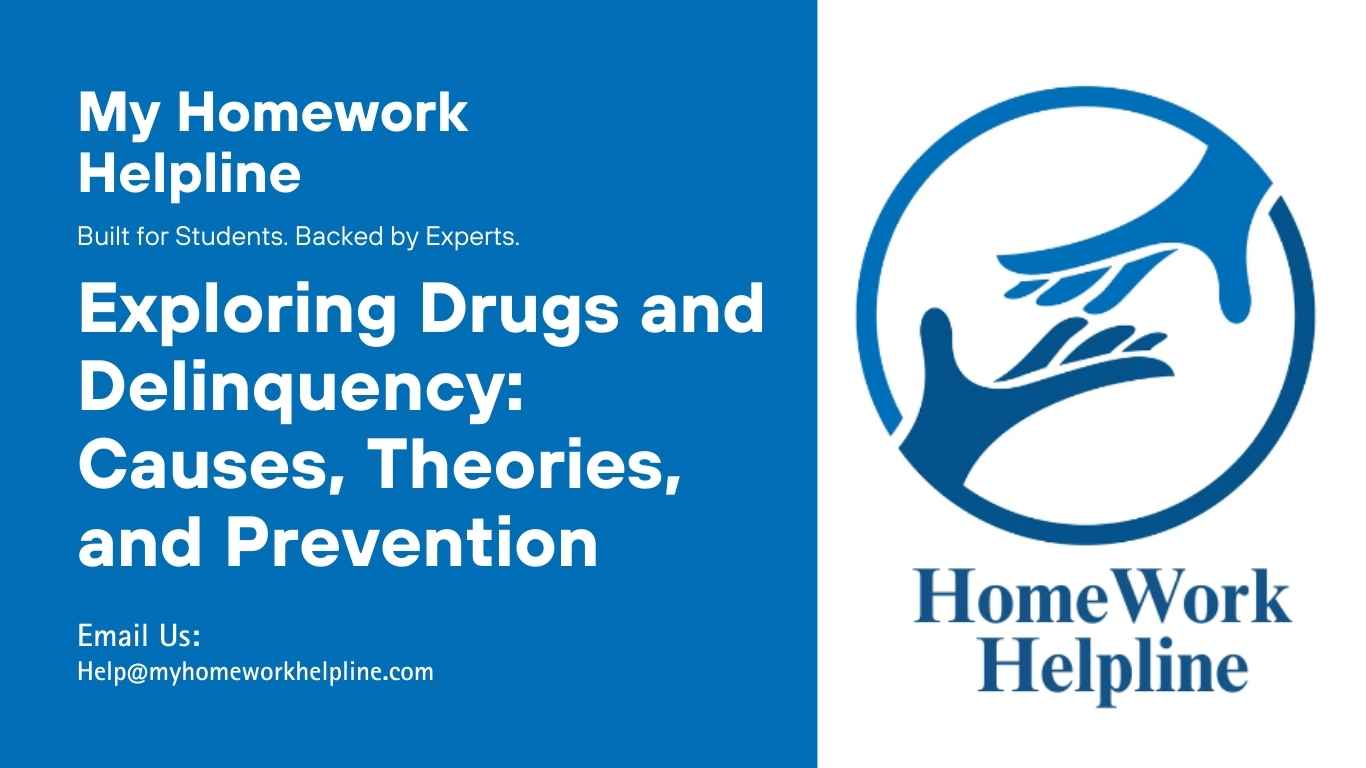Drugs and Delinquency Essay: Understanding Crime and Social Behavior
Understanding delinquency and violence must include any consideration of drugs because drugs are frequently an important part of the problem; drugs may spark criminal behavior, social instability, and public health crises with everything that implies. In terms of the age crime curve, chronic offenders, maturational reform, routine activity theory, and lifestyle theory, we can more easily see the connection between drug use and delinquent behavior.
Age-Crime Curve
The age crime curve is the correlation between an individual’s age and particular criminal activities, which peaks in the teenage years and soars into early adulthood (Fiveable, 2024). The trend is especially common when it comes to drug-related crime, as most people who experiment with or get involved in the drug trade are between the ages of 12 and 25. However, these behaviors are heightened by peer pressure, curiosity, and a lack of mature decision-making. Adolescents who turn to drugs to fit in or cope with stress are more likely to possess or traffic drugs. In reality, the curve follows a natural progression. As we age, we take on more responsibilities, add impulse control to the mix, and lose all of this behavior, similar to the curve’s movement.
Dive deeper into topics like drugs and delinquency with expert guidance from our sociology homework helpline. Our team helps students craft well-structured essays, analyze criminological theories, and present arguments clearly and effectively. Whether you need support with research, assignments, or essay writing, our professional help ensures your work is accurate, insightful, and academically sound. Strengthen your understanding and submit high-quality sociology essays with confidence using our tailored support.
Chronic Offenders
Drug-related crime is strongly associated with chronic offenders or people who repeatedly commit criminal acts (Meneghini & Calderoni, 2022). They are usually addicted the first time they use or sell drugs and remain involved because of addiction, financial need, or ingrained lifestyles. More often than not, chronic drug offenders cycle through the criminal justice system, ending a loop of substance abuse that perpetuates patterns of criminality. Drug dependence frequently results in individuals stealing or robbing to pay for addiction and, thus, trapping them further into the criminal underworld using those same ideas. Intervention strategies have to address the root causes of chronic offending, i.e., addiction treatment and social support.
Maturational Reform
The natural decline in criminal behavior with age is called maturational reform. This theory, in context with drugs, states that many offenders have outgrown substance-related criminal activities because of life changes, including stable employment, marriage, and parenthood. However, for chronic offenders who keep coming back to crime through their addiction or their environment, reform is unlikely. For example, people hooked on opioid cocktails cannot afford to do this (achieve stability), making rehabilitation programs geared towards issues of both the psychological and social aspects imperative.
Routine Activity Theory
Routine activity theory emphasizes that crimes occur when three elements converge: a motivated offender, a suitable target, and no capable guardianship. Pratt and Turanovic (2015) point out that drug-related crimes seem to fit this model. An example of where a motivated offender might target an unsecured home, say, to steal prescription drugs or money for drug purchases. Likewise, if a neighborhood has few law enforcers or community control, then it is more prone to open drug dealing or related violence. Strategies aimed at prevention based on this theory include increasing the amount of community surveillance and creating programs that will decrease the amount of opportunities for drug-related crimes.
Lifestyle Theory
Lifestyle theory suggests that a person’s lifestyle and social environment lead to a person’s involvement in being a criminal. Drug use is the result and fuel of a high-risk lifestyle (NIH, 2023). For example, people who visit bars and nightclubs in which drugs are prevalent are more likely to use or commit crimes directly involving drugs. Second, people get sucked into culturing drug use, which often leads them into subcultures that support activities such as trafficking and violence. This needs to be addressed, using comprehensive approaches such as education, social support, and finding safer recreational options.
Conclusion
How criminological theories make sense of this link between drugs and delinquency yields important insights in helping to solve this critical social problem. The age-crime curve and maturational reform document natural criminological autoregulation, while chronic offender illustrations suggest the despair of addressing entrenched cycles of crime. Routine activity and lifestyle theories add weight to the environmental and social importance. Multifaceted approaches to address drug-related delinquency include early intervention, addiction treatment, and community-based prevention programs. Using these concepts allows policymakers and practitioners to better cope with the drug among individuals and society.
References
Fiveable. (2024, August 21). Age-crime curve: Crime and Human Development Class Notes: Fiveable. All 38 AP Subjects. https://library.fiveable.me/crime-human-development/unit-2/age-crime-curve/study-guide/pGCnQQxSONJSS3Zz
Meneghini, C., & Calderoni, F. (2022). Co-offending and criminal careers in organized crime. Journal of Developmental and Life-Course Criminology, 8(3), 337–364. https://doi.org/10.1007/s40865-022-00202-1
NIH. (2023, December 21). Understanding drug use and addiction. National Institutes of Health. https://nida.nih.gov/publications/drugfacts/understanding-drug-use-addiction
Pratt, T. C., & Turanovic, J. J. (2015). Lifestyle and routine activity theories revisited: The importance of “risk” to the study of victimization. Victims & Offenders, 11(3), 335–354. https://doi.org/10.1080/15564886.2015.1057351

